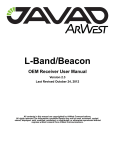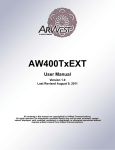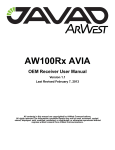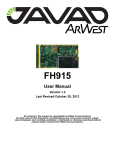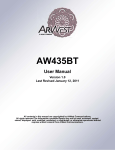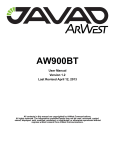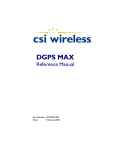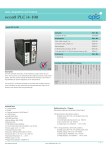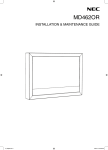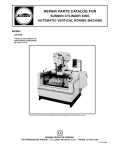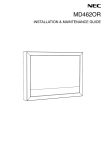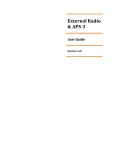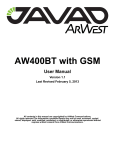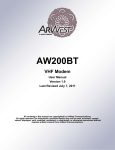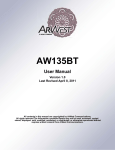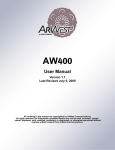Download ArWest Communications Beacon OEM receiver User Manual
Transcript
Beacon OEM Receiver User Manual Version 1.0 Last Revised November 29, 2012 All contents in this manual are copyrighted by ArWest Communications. All rights reserved.The information contained herein may not be used, accessed, copied, stored, displayed, sold, modified, published, or distributed, or otherwise reproduced without express written consent from ArWest Communications. www.arwestcom.com TABLE OF CONTENTS Preface . . . . . . . . . . . . . . . . . . . . . . . . . . . . . . . . . . . . . . . . . . . . . . . . . . . . . . . . .5 Terms and Conditions. . . . . . . . . . . . . . . . . . . . . . . . . . . . . . . . . . . . . . . . . . . . . . . . . . . . . . . . 5 WEEE Directive . . . . . . . . . . . . . . . . . . . . . . . . . . . . . . . . . . . . . . . . . . . . . . . . . . . . . . . . . . . . 7 Technical Assistance . . . . . . . . . . . . . . . . . . . . . . . . . . . . . . . . . . . . . . . . . . . . . . . . . . . . . . . . 8 Return Material Authorization . . . . . . . . . . . . . . . . . . . . . . . . . . . . . . . . . . . . . . . . . . . . . . . . . 8 Chapter 1. Product Features. . . . . . . . . . . . . . . . . . . . . . . . . . . . . . . . . . . . . . . .9 1.1. Introduction . . . . . . . . . . . . . . . . . . . . . . . . . . . . . . . . . . . . . . . . . . . . . . . . . . . . . . . . . . . . 9 1.1.1. Media Access Control (MAC) . . . . . . . . . . . . . . . . . . . . . . . . . . . . . . . . . . . . . . . 10 1.1.2. Management Tools . . . . . . . . . . . . . . . . . . . . . . . . . . . . . . . . . . . . . . . . . . . . . . . . 10 Chapter 2. General Description . . . . . . . . . . . . . . . . . . . . . . . . . . . . . . . . . . . .11 2.1. Physical Interfaces . . . . . . . . . . . . . . . . . . . . . . . . . . . . . . . . . . . . . . . . . . . . . . . . . . . . . . 11 2.1.1. Serial Data Interface . . . . . . . . . . . . . . . . . . . . . . . . . . . . . . . . . . . . . . . . . . . . . . . 11 2.1.2. Power Interface . . . . . . . . . . . . . . . . . . . . . . . . . . . . . . . . . . . . . . . . . . . . . . . . . . . 11 2.1.3. Power Consumption . . . . . . . . . . . . . . . . . . . . . . . . . . . . . . . . . . . . . . . . . . . . . . . 11 2.1.4. Antenna . . . . . . . . . . . . . . . . . . . . . . . . . . . . . . . . . . . . . . . . . . . . . . . . . . . . . . . . . 12 Chapter 3. Command Line Interface . . . . . . . . . . . . . . . . . . . . . . . . . . . . . . . .13 3.1. Command Line Interface Convention . . . . . . . . . . . . . . . . . . . . . . . . . . . . . . . . . . . . . . . 14 3.1.1. Software Switching to Maintenance Mode . . . . . . . . . . . . . . . . . . . . . . . . . . . . . . 14 3.1.2. Hardware Switching to Maintenance Mode . . . . . . . . . . . . . . . . . . . . . . . . . . . . . 15 3.1.3. Switching to Data Mode . . . . . . . . . . . . . . . . . . . . . . . . . . . . . . . . . . . . . . . . . . . . 15 3.2. Networking Commands . . . . . . . . . . . . . . . . . . . . . . . . . . . . . . . . . . . . . . . . . . . . . . . . . . 16 3.2.1. LINK . . . . . . . . . . . . . . . . . . . . . . . . . . . . . . . . . . . . . . . . . . . . . . . . . . . . . . . . . . . 16 3.2.2. MAP . . . . . . . . . . . . . . . . . . . . . . . . . . . . . . . . . . . . . . . . . . . . . . . . . . . . . . . . . . . 16 3.2.3. SCAN . . . . . . . . . . . . . . . . . . . . . . . . . . . . . . . . . . . . . . . . . . . . . . . . . . . . . . . . . . 17 3.2.4. ANTENNA . . . . . . . . . . . . . . . . . . . . . . . . . . . . . . . . . . . . . . . . . . . . . . . . . . . . . . 18 3.3. Serial Interfacing Commands . . . . . . . . . . . . . . . . . . . . . . . . . . . . . . . . . . . . . . . . . . . . . 18 3.3.1. PORT. . . . . . . . . . . . . . . . . . . . . . . . . . . . . . . . . . . . . . . . . . . . . . . . . . . . . . . . . . . 18 3.4. Special Commands . . . . . . . . . . . . . . . . . . . . . . . . . . . . . . . . . . . . . . . . . . . . . . . . . . . . . 19 3.4.1. ALARM. . . . . . . . . . . . . . . . . . . . . . . . . . . . . . . . . . . . . . . . . . . . . . . . . . . . . . . . . 19 3.4.2. BOOT . . . . . . . . . . . . . . . . . . . . . . . . . . . . . . . . . . . . . . . . . . . . . . . . . . . . . . . . . . 19 3.4.3. HELP . . . . . . . . . . . . . . . . . . . . . . . . . . . . . . . . . . . . . . . . . . . . . . . . . . . . . . . . . . . 19 www.arwestcom.com 3 3.4.4. SAVE . . . . . . . . . . . . . . . . . . . . . . . . . . . . . . . . . . . . . . . . . . . . . . . . . . . . . . . . . . 20 3.4.5. SLEEP . . . . . . . . . . . . . . . . . . . . . . . . . . . . . . . . . . . . . . . . . . . . . . . . . . . . . . . . . 20 3.5. Diagnostics and Identification Commands . . . . . . . . . . . . . . . . . . . . . . . . . . . . . . . . . . 21 3.5.1. INFO. . . . . . . . . . . . . . . . . . . . . . . . . . . . . . . . . . . . . . . . . . . . . . . . . . . . . . . . . . . 21 3.5.2. STATE . . . . . . . . . . . . . . . . . . . . . . . . . . . . . . . . . . . . . . . . . . . . . . . . . . . . . . . . . 22 Appendix A. Technical Specifications . . . . . . . . . . . . . . . . . . . . . . . . . . . . . . 23 A.1. Technical Specifications . . . . . . . . . . . . . . . . . . . . . . . . . . . . . . . . . . . . . . . . . . . . . . . . A.1.1. Beacon Receiver Specification . . . . . . . . . . . . . . . . . . . . . . . . . . . . . . . . . . . . . . A.1.2. General. . . . . . . . . . . . . . . . . . . . . . . . . . . . . . . . . . . . . . . . . . . . . . . . . . . . . . . . . A.1.3. Mechanical Properties For End-product . . . . . . . . . . . . . . . . . . . . . . . . . . . . . . . 23 23 23 24 A.2. External Connectors. . . . . . . . . . . . . . . . . . . . . . . . . . . . . . . . . . . . . . . . . . . . . . . . . . . . 25 A.2.1. Antenna Connector . . . . . . . . . . . . . . . . . . . . . . . . . . . . . . . . . . . . . . . . . . . . . . . 25 A.2.2. User Ports’ Connector (Main connector J1) . . . . . . . . . . . . . . . . . . . . . . . . . . . . 25 Appendix B. Safety Warnings . . . . . . . . . . . . . . . . . . . . . . . . . . . . . . . . . . . . . 27 B.1. General Warnings. . . . . . . . . . . . . . . . . . . . . . . . . . . . . . . . . . . . . . . . . . . . . . . . . . . . . . 27 Appendix C. Warranty Terms . . . . . . . . . . . . . . . . . . . . . . . . . . . . . . . . . . . . . 29 4 www.arwestcom.com PREFACE Thank you for purchasing this product. The materials available in this Manual (the “Manual”) have been prepared by ArWest Communications (“ArWest Communications”) for owners of ArWest Communications products. It is designed to assist owners with the use of the Beacon OEM Receiver and its use is subject to these terms and conditions (the “Terms and Conditions”). Note: Please read these Terms and Conditions carefully. Terms and Conditions COPYRIGHT – All information contained in this Manual is the intellectual property of, and copyrighted material of ArWest Communications. All rights are reserved. You may not use, access, copy, store, display, create derivative works of, sell, modify, publish, distribute, or allow any third party access to, any graphics, content, information or data in this Manual without ArWest Communications’ express written consent and may only use such information for the care and operation of your Beacon OEM Receiver. The information and data in this Manual are a valuable asset of ArWest Communications and are developed by the expenditure of considerable work, time and money, and are the result of original selection, coordination and arrangement by ArWest Communications. TRADEMARKS – ArWest, ArWest Communications® are trademarks or registered trademarks of ArWest Communications. Windows® is a registered trademark of Microsoft Corporation. Product and company names mentioned herein may be trademarks of their respective owners. DISCLAIMER OF WARRANTY – EXCEPT FOR ANY WARRANTIES IN THIS MANUAL OR A WARRANTY CARD ACCOMPANYING THE PRODUCT, THIS MANUAL AND THE Beacon OEM RECEIVER ARE PROVIDED “AS-IS.” THERE ARE NO OTHER WARRANTIES. ARWEST COMMUNICATIONS DISCLAIMS ANY IMPLIED WARRANTY OF MERCHANTABILITY OR FITNESS FOR ANY PARTICULAR USE OR PURPOSE. ARWEST COMMUNICATIONS AND ITS DISTRIBUTORS SHALL NOT BE LIABLE FOR TECHNICAL OR EDITORIAL ERRORS OR OMISSIONS CONTAINED HEREIN; NOR FOR INCIDENTAL OR CONSEQUENTIAL DAMAGES RESULTING FROM THE FURNISHING, PERFORMANCE OR USE OF THIS MATERIAL OR THE L-BAND/BEACON OEM RECEIVER. SUCH DISCLAIMED DAMAGES INCLUDE BUT ARE NOT LIMITED TO LOSS OF TIME, LOSS OR DESTRUCTION OF DATA, LOSS OF PROFIT, SAVINGS O R R E V E N U E , O R L O S S O F T H E P RO D U C T ' S U S E . I N A D D I T I O N , A RW E S T COMMUNICATIONS IS NOT RESPONSIBLE OR LIABLE FOR DAMAGES OR COSTS INCURRED IN CONNECTION WITH OBTAINING SUBSTITUTE PRODUCTS OR SOFTWARE, CLAIMS BY OTHERS, INCONVENIENCE, OR ANY OTHER COSTS. IN ANY EVENT, ARWEST COMMUNICATIONS SHALL HAVE NO LIABILITY FOR DAMAGES OR OTHERWISE TO YOU www.arwestcom.com 5 Preface Terms and Conditions OR ANY OTHER PERSON OR ENTITY IN EXCESS OF THE PURCHASE PRICE FOR THE LBAND/BEACON OEM RECEIVER. LICENSE AGREEMENT – Use of any computer programs or software supplied by ArWest Communications or downloaded from a ArWest Communications website (the “Software”) in connection with the Beacon OEM Receiver constitutes acceptance of these Terms and Conditions in this Manual and an agreement to abide by these Terms and Conditions. The user is granted a personal, non-exclusive, nontransferable license to use such Software under the terms stated herein and in any case only with a single Beacon OEM Receiver or single computer. You may not assign or transfer the Software or this license without the express written consent of ArWest Communications. This license is effective until terminated. You may terminate the license at any time by destroying the Software and Manual. ArWest Communications may terminate the license if you fail to comply with any of the Terms or Conditions. You agree to destroy the Software and manual upon termination of your use of the Beacon OEM Receiver. All ownership, copyright and other intellectual property rights in and to the Software belong to ArWest Communications. If these license terms are not acceptable, return any unused software and manual. CONFIDENTIALITY – This Manual, its contents and the Software (collectively, the “Confidential Information”) are the confidential and proprietary information of ArWest Communications. You agree to treat ArWest Communications' Confidential Information with a degree of care no less stringent that the degree of care you would use in safeguarding your own most valuable trade secrets. Nothing in this paragraph shall restrict you from disclosing Confidential Information to your employees as may be necessary or appropriate to operate or care for the Beacon OEM Receiver. Such employees must also keep the Confidentiality Information confidential. In the event you become legally compelled to disclose any of the Confidential Information, you shall give ArWest Communications immediate notice so that it may seek a protective order or other appropriate remedy. WEBSITE; OTHER STATEMENTS – No statement contained at the ArWest Communications website (or any other website) or in any other advertisements or ArWest Communications literature or made by an employee or independent contractor of ArWest Communications modifies these Terms and Conditions (including the Software license, warranty and limitation of liability). SAFETY – Improper use of the Beacon OEM Receiver can lead to injury to persons or property and/or malfunction of the product. The Beacon OEM Receiver should only be repaired by authorized ArWest Communications warranty service centers. Users should review and heed the safety warnings. MISCELLANEOUS – The above Terms and Conditions may be amended, modified, superseded, or canceled, at any time by ArWest Communications. The above Terms and Conditions will be governed by, and construed in accordance with, the laws of the State of California, without reference to conflict of laws. 6 www.arwestcom.com Preface WEEE Directive WEEE Directive The following information is for EU-member states only: The use of the symbol indicates that this product may not be treated as household waste. By ensuring this product is disposed of correctly, you will help prevent potential negative consequences for the environment and human health, which could otherwise be caused by inappropriate waste handling of this product. For more detailed information about the take-back and recycling of this product, please contact your supplier where you purchased the product or consult. www.arwestcom.com 7 Preface Technical Assistance Technical Assistance If you have a problem and cannot find the information you need in the product documentation, contact your local dealer. Alternatively, request technical support using the ArWest Communications World Wide Web site at: www.arwestcom.com Return Material Authorization Initially, the customer contacts support to r e p or t a p r o b l e m . P l e a s e r e f e r t o s u p p o r t : [email protected] If support determines the problem cannot be resolved over e-mail/internet, it will authorize the return of the unit for repair or replacement, depending on the nature of the problem. 8 www.arwestcom.com Chapter 1 PRODUCT FEATURES 1.1. Introduction Marine Radiobeacon receiver (283.5 to 325 kHz) or Beacon receiver complies with Broadcast Standard for the USCG DGPS Navigation Service COMDTINST M16577.1. Beacon receiver is designed to receive pseudorange corrections transmitting by Radiobeacon stations. Maritime Radiobeacon DGNSS systems according to RTCM SC-104 version 2.3 are usually capable of broadcasting the following RTCM messages: 1, 2, 3, 5, 6, 7, 9, 15 (seldom), and 16. Radiobeacons are widely used throughout the world. GNSS Radiobeacon transmissions meet stringent integrity and reliability requirements mandated by the International Association of Lighthouse Authorities. Figure 1-1. Beacon Receiver The delivered product is a wireless system, which includes: • Beacon Receiver – Beacon receiver OEM board; • AWLaunch – Windows based Unit Configuration and Maintenance Software Application running on a IBM PC compatible computer and connecting to the device over RS-232 interface or USBto-Serial adapter. The setting can be done through the built-in Command Line interface (CLI), or through the configuration and maintenance application software running either on PC – AWLaunch. The diagnostic feature of the Beacon Receiver system provides the information to monitor and maintain user’s communications link. The product is designed for maximum performance and reliability even in the hardest environments. Plug and play at its best, robust, withstanding the most adverse of conditions. www.arwestcom.com 9 Product Features Introduction Media Access Control (MAC) 1.1.1. Media Access Control (MAC) The following Media Access protocols are available for Beacon OEM Receiver modem: 1. Beacon protocols 2. Sleep mode1 is an investment provided by MAC sub-layer that provides additional power saving. The wakeup from Sleep mode is user selectable either by an internal real-time clock, or by an external controller through the data interface control lines (RTS or DTR), or by SLEEP input line (CMOS/TTL compatible input lines). 1.1.2. Management Tools The built-in management tools along with AWLaunch (configuration and monitoring software application) will provide the following benefits: 1. Easy user’s interface for system configuration and monitoring using well developed CLI or intuitive GUI. 2. An ability to monitor status, alarms and radio performance through the intuitive GUI. 3. Software upgrades and improvements can be downloaded from AWLaunch to the units connected with PC/PDA. 1. This feature is not supported in the current firmware version, it will be supported in the future. 10 www.arwestcom.com Chapter 2 GENERAL DESCRIPTION 2.1. Physical Interfaces 2.1.1. Serial Data Interface The serial asynchronous interface allows connection to external serial devices through RS232 interface. It is shared between user data and unit’s command/status information. The following options of serial port parameters are supported: Table 2-1. Serial port parameters Parameter Options Baud rate 115200, 57600, 38400, 19200, 14400, 9600, 4800, 2400, 1200 bauds per second Flow control None, Hardware Data bits 8 Stop bits 1, 2 Parity None 2.1.2. Power Interface The power interface allows connection to an unregulated DC power source. The DC power source (thirdparty or user supplied) must provide DC power of 4.2V±5% DC. 2.1.3. Power Consumption Power consumption of the Beacon OEM receiver at receiving mode is 1400 mW (refer to Table 2-2 for details). Table 2-2. Power Consumption Operating Mode / Description Consumption Maximum for Rx Full Operation Mode 1400 mW Sleep Mode 300 mW Standby Mode, ordered by SLEEP input pin 500 W www.arwestcom.com 11 General Description Physical Interfaces Antenna 2.1.4. Antenna The Beacon receiver should be used with 283.5 - 325 kHz antenna with following parameters: • LNA Gain P30 dB • LNA Noise Figure 1.5 dB 12 www.arwestcom.com Chapter 3 COMMAND LINE INTERFACE The built-in user-friendly Command Line Interface (CLI) allows user to perform a full configuration of the unit and read the statistics and alarm status. It is the most powerful tool to configure the unit. It makes changes to all possible settings that system will not be able to determine automatically. The CLI commands allow user to configure and reconfigure the unit’s settings. The user configuration parameters that could be changed through the CLI are: • Data Port Settings - Baud Rate - Flow control (None or RTS/CTS) - Stop bits • Alarm Settings1 • Radio operation modes • Scanning modes • Sleep modes2 - On/Off - Activate by internal real-time clock - Activate through RTS/CTS lines - Activate by external sense lines - Activate by any combination of the parameters mentioned before Note: The unit’s configuration that is set or modified through the CLI will be lost after unit’s reboot, unless the saving operation is used to store a new setting in the unit’s configuration file. The CLI commands also provide filing operations, which include: • Downloading - Unit’s Configuration files - Software Images • Uploading Unit’s Configuration files • Saving into the configuration files the configuration parameters modified through the CLI. 1. The Alarm is not supported currently. It will be supported in the future firmware version. 2. The Sleep is not supported currently. It will be supported in the future firmware version. www.arwestcom.com 13 Command Line Interface Command Line Interface Convention Software Switching to Maintenance Mode 3.1. Command Line Interface Convention The following convention is implemented in Beacon Receiver Command Line Interface (CLI): • The Carriage Return/Line Feed (CR/LF, 0x0D/0x0A) is a command delimiter. • The Carriage Return/Line Feed (CR/LF, 0x0D/0x0A) is a reply delimiter followed by the “CLI>” prompt if Echo option is On. • The Carriage Return/Line Feed (CR/LF, 0x0D/0x0A) is a reply delimiter if Echo option is Off (default option). • The 2-digit number followed by “@” in the unit’s reply indicates the error code (refer to Table 31 for description). • A successfully performed command is replied by @00 code for both Echo ON and OFF modes. • A command with the certain [Parameter Name] and blank [Parameter List] displays the current settings for a given parameter. • To set the mode ordered by CLI commands as permanent User Setting (the setting automatically selected for the boot-up unit) the SAVE command must be asserted. • [/?] orders to show the help information for the given command. • Commands are not key sensitive; small, none capital characters can be used to enter CLI commands. Table 3-1. Command Line Interface Error Codes Error Code Short Description 0x01 Command Syntax Error. A command followed by “/?” displays a command usage. 0x02 The parameter has a format error. A command with the certain [Parameter Name] followed by “/ ?” displays the format and range of the variable. 0x03 The parameter is out of allowed range. A command with the certain [Parameter Name] followed by “/?” displays the format and range of the variable. 0x04 The command is not valid for specific radio model. To display the list of available commands, the HELP command must be used (see “Software Switching to Maintenance Mode” ). 0x05 Unspecified Error 3.1.1. Software Switching to Maintenance Mode To switch to Maintenance mode the special byte-sequences with special meanings are used: • Escape-Sequence: “+++” with 20 ms guard time before and after the command characters • Escape-Acknowledge: “@00<CR><LF>” 20 ms toggling on CTS control line needed to acknowledge switching from Data to Maintenance mode and vice versa. In Maintenance mode, the unit’s serial port must keep CTS line always active. 14 www.arwestcom.com Command Line Interface Command Line Interface Convention Hardware Switching to Maintenance Mode Happy Flow 1. In data-mode the unit starts looking for the Escape-sequence if there is no data from DTE for more than 20 ms (Start Guard Time). 2. If the unit detects the Escape-Sequence: • The Receiver immediately stops forwarding to DTE the data received over the air and buffers it instead. 3. The radio unit waits for 20 ms and then sends Escape-Acknowledge to DTE if there is no data from DTE during 20 ms of Stop Guard Time. 4. The unit goes to Maintenance mode and discards Escape-Sequence from input buffer. The modem is immediately ready to receive commands. At the same time it continues buffering the data received over the air since step 2. 3.1.2. Hardware Switching to Maintenance Mode As alternative to Software Switching, the switching through the MP/DP control line can be used (this control line can be also used as Data Terminal Ready, DTR). To set Maintenance mode, the DTE must assert DTR signal active (0v level). By falling edge of DTR signal the unit goes to Maintenance mode and then sends Escape-Acknowledge to DTE („@00<CR><LF>“). 20 ms toggling on CTS control line followed by Escape-Acknowledge response is needed to acknowledge switching from Data to Maintenance mode and vice versa. In Maintenance Mode, the unit’s serial port must keep Clear to Send (CTS) line always active (see also “Special Commands” on page 19). Note: The powered up radio modem always goes to data mode. 3.1.3. Switching to Data Mode • DTE sends the CLI command „DATAMODE<CR><LF>“to the unit. • Unit immediately goes to data mode without Escape Acknowledge. • If no valid CLI commands received from DTE within 1 minute, the unit will automatically switch back to data-mode. Note: The data received over the air could be lost due to Rx buffer overflow if the unit stays in Maintenance mode longer than 15 seconds. www.arwestcom.com 15 Command Line Interface Networking Commands LINK 3.2. Networking Commands 3.2.1. LINK The LINK command is responsible for configuring radio’s operation mode. LINK [Parameter Name] [Parameters List] [/?] Parameter Name Parameter List CHAN Sets/gets the current frequency channel number. Up to 32 channels are available in the channel map (example LINK CHAN 24). Refer to MAP command about creating and modifying the channel map. SIGTYPE Sets/gets the signal type 1 - 100 bps 2 - 200 bps 3 - 50 bps 3.2.2. MAP The MAP command is used to create, modify and save the frequency channel map of the Beacon receiver. MAP [C<Parameter>][F<Parameter>][SAVE] Parameter Name Description C Channel number (1- 32) F Carrier frequency in Hz SAVE Saves the channel map The MAP command without parameters displays the channel map of the active receiver.: Example: MAP c1 F314000 - sets the 314 kHz frequency to channel number 1; MAP SAVE - saves the channel map. 16 www.arwestcom.com Command Line Interface Networking Commands SCAN 3.2.3. SCAN The SCAN command is used to set/configure scanning modes. For Automatic scanning mode it is possible to select the Frequency scanning and Signal type scanning criteria. SCAN [Parameter Name] [Parameters List] [/?] Parameter Name Parameter List MODE Sets/gets the scanning mode 0 – Manual 1 – Automatic Refer to “Beacon scanning modes” for scanning modes description. FREQ Sets/gets the frequency scanning criterion 1 – Full range scanning with 500 Hz step 2 – Channel map scanning Parameter FREQ is available for Automatic scanning mode only. SIGTYPE Sets/gets the signal type scanning mode 1 – 100 bps signals are scanned 2 – 200 bps signals are scanned 3 – 50 bps signals are scanned 4 – All signal types (200 bps, 100 bps, 50 bps) are scanned Parameter SIGTYPE is available for Automatic scanning mode only. ALMANAC Returns the Almanac table of available Beacon reference stations scanned by second (Slave) Beacon receiver. Each line of the table contains information (Frequency, RSSI, Signal type, Reference station ID) about one Beacon reference station. The following is the structure of the Almanac table’s line: <Frequency in Hz> <TAB> <RSSI in dBm> <TAB> <Signal type> <TAB> <REF Station ID> <CR> <LF> Beacon Scanning modes Beacon has the following two scanning modes: 1. Automatic (searching Beacon reference stations) In this mode two independent Beacon channels start cooperative searching of Beacon reference stations using the selected criteria in 1.1 and 1.2. Each found reference station is recorded in the Almanac table where the following parameters of found station are specified: frequency, signal type, RSSI and Reference station ID. The RSSI parameter is recorded to determine the station providing the best RTCM signal. If no Beacon reference station is available the searching cycle is continued until one reference station is found. The Master Beacon locks to the first found reference station and starts RTCM data demodulation while the Slave Beacon continues searching in the background. If a synchronization loss occurs on Master Beacon then it switches to the best RTCM signal (which has the highest RSSI) from the list of Beacon reference stations recorded by Slave Beacon. The following are the Beacon reference station searching criteria used in the algorithm of Automatic scanning mode. 1.1. Frequency scanning criteria • Full range scanning with 500 Hz step – full frequency range is scanned with 500 Hz step (83 steps in the range from 283.5 kHz to 325 kHz); • Frequency map scanning – only the frequencies defined in the frequency map are scanned. www.arwestcom.com 17 Command Line Interface Serial Interfacing Commands ANTENNA 1.2. Signal type scanning criteria • • • • All – On each step of frequency scanning all signal types are scanned (200bps, 100bps, 50bps) 200 bps – only 200 bps signals are taken into account; 100 bps – only 100 bps signals are taken into account; 50 bps – only 50 bps signals are taken into account. Note: If in Automatic scanning mode the frequency channel or signal type is selected (by LINK CHAN and LINK SIGTYPE commands correspondingly) then the scanning mode is switched to Manual by the firmware automatically. 2. Manual In this mode operator specifies the frequency (in the range from 283.5 kHz to 325 kHz) and signal type (200 bps, 100 bps or 50 bps) for Master Beacon to tune. The Slave Beacon performs Full range scanning for all signal types and fills the Almanac table in parallel. 3.2.4. ANTENNA The ANTENNA command is used to set the antenna power state of the external connector. ANTENNA [Parameter Name] [Parameters List] [/?] Parameter Name POWER Parameter List 0 - Switches off the antenna power on connector 1 - Switches on the antenna power on connector 3.3. Serial Interfacing Commands 3.3.1. PORT The PORT command is responsible for data port interface configuration. The baud rate, flow control and stop bits can be configured. The data bits is set to 8 and parity to None in the firmware. PORT [Parameter Name] [Parameters List] [/?] Parameter Name 18 Parameter List RATE 1 - 1200 baud rate 2 - 2400 baud rate 3 - 4800 baud rate 4 - 9600 baud rate 5 - 14400 baud rate 6 - 19200 baud rate 7 - 38400 baud rate 8 - 57600 baud rate 9 - 115200 baud rate FLOW 0 – No flow control 2 – Hardware flow control is on STOPBIT 0 - 1 stop bit, a default setting 1 - 2 stop bits www.arwestcom.com Command Line Interface Special Commands ALARM 3.4. Special Commands 3.4.1. ALARM1 The ALARM command is intended to set up the alarm indication mode and alarm control lines’ behavior. ALARM [Parameter Name] [Parameters List] [/?] Parameter Name Parameter List TTL1 0 – TTL_OUT1 = logic “1” 1 – TTL_OUT1 = TTL_IN, received from remote unit (default settings) TTL2 0 – TTL_OUT2 = logic “1” 1 – TTL_OUT2 = TTL_IN2, received from remote unit (default settings) 2 – TTL_OUT2 = SYNC Loss 3.4.2. BOOT The BOOT command is intended to reboot the unit using selected user settings. 3.4.3. HELP The HELP command types the list of all available commands: HELP XMOD BOOT LINK SCAN PORT STATE SAVE INFO MAP ANTENNA DATAMODE COMMAND /? - Display this usage Activate X-Modem Protocol Reboot the unit Set RF Link Operation Mode Set scanning options and criteria Set Data Port Configuration Display Status and Statistics Save Current Configuration into Configuration File Display Product ID along with Hardware/Software Versions Operate with Channel Map Set the State of antenna power and selects the RF connector for Beacon receiver Exit Command Mode Display Command Usage 1. Not supported in the current firmware version www.arwestcom.com 19 Command Line Interface Special Commands SAVE 3.4.4. SAVE The SAVE command is intended to store the unit’s currently used configuration into the User Configuration file. The configuration stored in the User Configuration file is used for next boots. 3.4.5. SLEEP1 The SLEEP command determines the sleep mode parameters. The sleeping Beacon OEM Receiver can be activated by real-time CLK, DTR/RTS lines, and command received through TTL inputs. The user can select one, two, or all three conditions. SLEEP [Parameter Name] [Parameters List] [/?] Parameter Name Parameter List CLK 0 – Do not activate by internal real-time clock (1 – 255) – Activate by internal real-time clock after 100 to 25500 msec of sleeping HW 0 – Do not activate through DTR/RTS lines 1 – Activate through DTR/RTS lines TTL 0 – Do not activate by external sense lines 1 – Activate by external sense lines GTS 0 – Disable Sleep mode (default) (1 – 255) – Go to sleep mode if there is no activity in 10 to 2550 msec Example: SLEEP GTS 100 (go to sleep if there is no activity in 1000 ms) 1. Not supported in the current firmware version 20 www.arwestcom.com Command Line Interface Diagnostics and Identification Commands INFO 3.5. Diagnostics and Identification Commands 3.5.1. INFO The INFO command is used to retrieve the Radio ID along with its Hardware version, the loaded realtime software version/revision and BootLoader’s version/revision. INFO [Parameter Name] [Parameters List] [/?] Parameter Name Parameter List ID Retrieves the device identifier. SN Retrieves the serial number of the modem (unique for each unit). HW Retrieves the version string of the hardware. 1.0 – hardware version in numeric “Major.Minor” format SW Retrieves the version string of the current firmware. Ver. 1.0 Rev. A – displays software’s version in numeric “Major.Minor” format and revision in numeric format (range from 01 to 99) for engineering releases and alphabetic format (A to Z) for manufacturing releases. BL Retrieves the version string of the BootLoader. Ver. 1.0 Rev. A – displays BootLoader’s version in numeric “Major.Minor”format and revision in numeric format (range from 01 to 99) for engineering releases and alphabetic format (A to Z) for manufacturing releases. The INFO command without Parameter Name indicates all values: Beacon Receiver Product ID = 69 S/N = 000000 020303 Hardware = Ver 3.1 Software = Ver. 1.8 Rev 05 BootLoader = Ver. 3.0 Rev. 02 www.arwestcom.com 21 Command Line Interface Diagnostics and Identification Commands STATE 3.5.2. STATE The STATE command is used to check the wireless link state of the Beacon receiver. STATE [Parameter Name] [Parameters List] [/?] Parameter Name 22 Parameter List RSSI Retrieves the calculated received signal level in dBm. SYNC Indicates the synchronization status: 0 - no synchronization 1 - synchronization established FREQ Retrieves the current channel frequency in Hz. FREQOFFSET Retrieves the tuned frequency offset relative to the set frequency after the synchronization established. SYMRATE Retrieves the current symbol rate. TEMP -30oC to +100oC retrieves the temperature inside enclosure. www.arwestcom.com Appendix A TECHNICAL SPECIFICATIONS A.1. Technical Specifications A.1.1. Beacon Receiver Specification Figure A-1. Beacon Receiver Specification Component Details Frequency Range 283.5 - 325 kHz Channel Spacing 500 Hz Bit Rates 50, 100, 200 bps (manual or Auto selection) Channels 2-channel, parallel operating Operation Mode manual/automatic Adjacent Channel Rejection 65 dB ± 1 dB @ for ± 400 Hz Cold Start Time <1 min Warm Start Time <2 seconds Modulation Minimum Shift Keying (MSK) Sensitivity 1.5 µVm for 6 dB SNR (200 bps) Dynamic Range 100 dB Frequency Offset ± 0.5 Hz (~ 1.5 ppm) Correction Output Protocol RTCM SC-104 A.1.2. General Component Details Input Voltage 4.2 V ± 5% Power Consumption 1400 mW Operation Temperature -40oC - +75oC Storage Temperature -40oC - +80oC Dimensions L: 80 mm x W: 46.5 mm x H: 7.6 / 9.5 mm Weight 41 g www.arwestcom.com 23 Technical Specifications Technical Specifications Mechanical Properties For End-product Features • • • • • DSP-Modem Multi-Modulation Technologies Zero-IF Technologies Up to 115200 bps Data Rate Compact Design A.1.3. Mechanical Properties For End-product Dimensions for PCB Mounted Enclosure: 80 mm x W: 46.5 mm x H: 7.6/9.5 mm (3.15" x 1.83" x 0.3") 24 www.arwestcom.com Technical Specifications External Connectors Antenna Connector A.2. External Connectors A.2.1. Antenna Connector Through the central pin of the connector the power is being supplied to the antenna LNA. The internal power supply provides 4.2 V DC and max 0.2 A. If an antenna needs another voltage, the external power supply should be connected to the pin 10 of main connector J1. If jumper R117 is installed, the antenna supply voltage through the central pin of antenna connector is equal to the external voltage applied to this pin. The external voltage should be in range +5 ... +15 VDC and the current is less than 0.2 A. A.2.2. User Ports’ Connector (Main connector J1) The user ports’ connector is used to provide connection with an external DTE or with the PC running AWLaunch management software applications. Beacon Receiver in PCB mounted enclosure uses 16-Lead Header Connector, ECS Corp. P/N 9616-D101-03. PIN # Signal Designator 1 GND 2 Signal name GND Description I/O Comments Ground - Signal and Chassis Ground DSP UART 1 TXD Transmit Data TTL Input Serial Data Input 3 DSP UART 2 RXD Receive Data TTL Output Output for received serial data 4 DPORT5 DTR or DP/MP Data Terminal Ready TTL Input 5 DPORT1 CTS Clear to Send TTL Output Used to control data flow from the user to the radio: (0V) –Data buffer not full, (3.3V) – Data buffer full 6 TTLI1 SLEEP Sleeps/wakes radio Receive only TTL Input 7 DPORT3 DCD Data Carrier Detect TTL Output Used by remote to indicate that the remote has successfully acquired the signal from base station: (0V) – Carrier detected (synchronized); (3.3V) – No carrier detected (not synchronized) www.arwestcom.com Control line can be used as a backup method for entering Command mode: (0V) – Maintenance Mode; (3.3V) – Data Mode An internal 100K pull-up enables Data Mode if this signal is left unconnected. Maintenance Mode is also accessible by transmitting an escape sequence In sleep mode, all radio functions are disabled consuming less than 50ìA. An internal 10K pull-down wakes up the radio if this signal is left unconnected. At wake up, any user programmed configuration settings are refreshed from flash memory, clearing any temporary settings that may have been set: (3.3V) – Sleep Radio; (0V) – Wake Radio As an option could be used as TTL Input Line 1 25 Technical Specifications External Connectors User Ports’ Connector (Main connector J1) PIN # Signal Designator Signal name Description I/O Comments 8 DPORT4 RTS Request to Send TTL Input 9 DPORT2 DSR Data Set Ready TTL Output Used to control transmit flow from the user to the radio: (0V) – Receive buffer has data to transfer; (3.3V) – Receive buffer is empty 10 ANT_DC ANT_DC External Power for Antenna LNA Power Input External Power for Antenna LNA +5...+15 VDC 11 TTLO1 TTLOUT1 TTL Output Line 1 TTL Output Reserve line 12 TTLO2 TTLOUT2 TTL Output Line 2 TTL Output Reserve line 13 GND GND Ground - Signal and Chassis Ground 14 TTLI2 TTLIN TTL Input line TTL Input An internal 100K pull-up resistor is applied 15 VCC42 PWR Power Supply External Regulated positive 4.2V DC from ext. Power Supply 16 VCC42 PWR Power Supply External Regulated positive 4.2V DC from ext. Power Supply 26 Gates the flow of receive data from the radio to the user on or off. An internal 10K pull-down enables data receive if this signal is left unconnected. In normal operation, this signal should be asserted: (0V) – Receive data (RxD) enabled (3.3V) – Receive data (RxD) disabled www.arwestcom.com Appendix B SAFETY WARNINGS Read these instructions. • • • • • • • • • • Keep these instructions. Heed all warnings. Follow all instructions. Clean only with a damp cloth. Do not block any of the ventilation openings. Install in accordance with the manufacturer's instructions. Do not install near any heat sources such as radiators, heat registers, stoves, or other apparatus (including amplifiers) that produce heat. Protect the power cord from being walked on or pinched particularly at plugs, convenience receptacles, and the point where they exit from the apparatus. Only use attachments/accessories specified by the manufacturer. Refer all servicing to qualified service personnel. Servicing is required when the apparatus has been damaged in any way, such as power-supply cord or plug is damaged, liquid has been spilled or objects have fallen into the apparatus, or has been dropped. Apparatus shall not be exposed to dripping or splashing and no objects filled with liquids, shall be placed on the apparatus. B.1. General Warnings This product should never be used: • • • • Without the user thoroughly understanding operator’s manual. After disabling safety systems or altering the product. With unauthorized accessories. Contrary to applicable laws, rules, and regulations. DANGER: THE BEACON RECEIVER SHOULD NEVER BE USED IN DANGEROUS ENVIRONMENTS. www.arwestcom.com 27 Safety Warnings General Warnings 28 www.arwestcom.com Appendix C WARRANTY TERMS ArWest Communications Corp., Inc. (“Company”) warrants, to the end-user only, that the Narrow Band Radio Modems (“Radios”) purchased (a) conforms to the Company’s published specifications for the model purchased, and (b) is free from defects in material or workmanship. The duration of this warranty is twelve (12) months1 from date of purchase and any claim for breach of warranty must be brought to the Company’s attention within such twelve (12) month period and the Receiver must be returned for action on any such claim within twelve (12) months from the date of purchase. Within a reasonable period of time after a claim, the Company will correct any failure of the Radio to conform to specifications or any defect in materials or workmanship, or replace the Radio, or, at its option, provide a full refund of the purchase price. A repaired or replaced product is warranted for 90 days from the date of return shipment to the buyer, or for the balance of the original warranty period, whichever is longer. These remedies are the buyer’s exclusive remedies for breach of warranty. To obtain warranty service, the buyer must return the Radio, postage-paid, with proof of the date of original purchase and the buyer's return address to the Company or an authorized service center. The Company will not be responsible for any loss or damage to the product incurred while it is in transit or is being shipped for repair. It is the buyer's responsibility to arrange for insurance, if the buyer so desires. The Company does not warrant (a) any product, components or parts not manufactured by the Company, (b) defects caused by failure to provide a suitable installation environment for the Radio, (c) damage caused by disasters such as fire, flood, wind, and lightning, (e) damage caused by unauthorized attachments or modification, (f) damage during shipment, (g) any other abuse or misuse by the buyer, (h) that the Radio will be free from any claim for infringement of any patent, trademark, copyright or other proprietary right, including trade secrets. THE FOREGOING WARRANTIES ARE IN LIEU OF ALL OTHER WARRANTIES, EXPRESS OR I M P L I E D , I N C L U D I N G BU T N OT L I M I T E D TO T H E I M P L I E D WA R R A N T I E S O F MERCHANTABILITY AND FITNESS FOR A PARTICULAR PURPOSE, AND IF APPLICABLE, IMPLIED WARRANTIES UNDER ARTICLE 35 OF THE UNITED NATIONS CONVENTION ON CONTRACTS FOR THE INTERNATIONAL SALE OF GOODS. IN NO CASE SHALL THE COMPANY BE LIABLE FOR ANY SPECIAL, INCIDENTAL, OR CONSEQUENTIAL DAMAGES ARISING DIRECTLY OR INDIRECTLY OUT OF THE OWNERSHIP, USE OR OPERATION OF THE RADIO REGARDLESS OF WHETHER SUCH DAMAGES ARE PREDICATED OR BASED UPON BREACH OF WARRANTY, BREACH OF CONTRACT, NEGLIGENCE, STRICT TORT, OR ANY OTHER LEGAL THEORY. SUCH DAMAGES INCLUDE, BUT ARE NOT LIMITED TO, LOSS OF PROFITS, LOSS OF SAVINGS OR REVENUE, LOSS OF USE OF THE RADIO OR ANY ASSOCIATED EQUIPMENT, COST OF CAPITAL, COST OF ANY SUBSTITUTE EQUIPMENT, FACILITIES OR SERVICES, THE CLAIMS 1. The warranty against defects in ArWest adapter, antenna, battery, charger, or cable is 90 days. www.arwestcom.com 29 Warranty Terms OF THIRD PARTIES, INCLUDING CUSTOMERS AND INJURY TO PROPERTY. THIS LIMITATION DOES NOT APPLY TO CLAIMS FOR PERSONAL INJURY. SOME STATES DO NOT ALLOW LIMITS ON WARRANTIES, OR ON REMEDIES FOR BREACH IN CERTAIN TRANSACTIONS. IN SUCH STATES, THE LIMITS IN THIS PARAGRAPH AND THE PRECEDING PARAGRAPH MAY NOT APPLY. No employee of the Company, or any other party, is authorized to make any warranty in addition to those made in this document. This warranty allocates the risks of product failure between the Company and the buyer. This allocation is recognized by both parties and is reflected in the price of the goods. The buyer acknowledges that it has read this warranty, understands it, and is bound by its terms. This limited warranty is governed by the laws of the State of California, without reference to its conflict of law provisions or the U.N. Convention on Contracts for the International Sale of Goods. 30 www.arwestcom.com READER COMMENT FORM We appreciate your comments and suggestions for improving this publication. I use the following ArWest product ______________________________________________________ for ________________________________________________________________________________ Please circle a response for each of the statements below: 1 = Strongly Agree 2 = Agree 3 = Neutral 4 = Disagree 5 = Strongly Disagree The manual is well organized. I can find the information I want. The information in the manual is accurate. I can easily understand the instructions. The manual contains enough examples. The examples are appropriate and helpful. The layout and format are attractive and useful. The illustrations are clear and helpful. The manual is: Please answer the following questions: 1 2 3 4 5 1 2 3 4 5 1 2 3 4 5 1 2 3 4 5 1 2 3 4 5 1 2 3 4 5 1 2 3 4 5 1 2 3 4 5 too long just right too short Which sections do you use the most? _____________________________________________________ What do you like best about the manual? __________________________________________________ What do you like least about the manual? __________________________________________________ Optional Name _____________________________________________________________________ Company __________________________________________________________________ Address____________________________________________________________________ __________________________________________________________________________ Telephone ____________________________ Fax __________________________________ Please mail to the ArWest local office listed on the back cover. All comments and suggestions become the property of ArWest Communications. www.arwestcom.com 900 Rock Avenue, San Jose, CA 95131 USA Tel: + 1(408) 770-1790 Fax: + 1(408) 770-1799 www.arwestcom.com Copyright © ArWest Communications, 2012 All rights reserved. No unauthorized duplication.
































